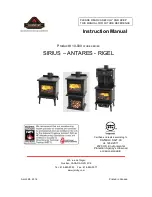
22
Chimney with a proper draught
Warm air wants to ascend. This is the principle of every chimney. It helps when the wind near the
chimney mouth draws the air from the chimney.
Fall wind may give the opposite effect and blow the air back into the chimney. Relatively cold foggy
air may thwart proper draught in your chimney as does a long flue pipe with a rough inside and many
bends. If the natural draught in your chimney is poor your installer can give you information about
using a ventilator for your flue tube.
What to do in case of chimney fire
In case of chimney fire, immediately close the shut-off valve in the chimney and all air supply ducts.
Call the fire department. After the fire is extinguished, the chimney and the stove must be inspected
again by your installer.
Maintenance
Small maintenance
t
Remove the cooled-down ash from the stove two or three times a week. It is advisable to use an ash
bucket.
t
It is advisable to leave an ash layer of two to three centimetres on the fire plate. It will protect the material.
t
Clean the exterior of the stove with a soft cloth that does not give off fluff. Do not use any aggressive
cleansing agents or abrasives.
t
Do not use any water because of the soapstone
t
Clean the cold glass pane with a cleaning agent for ceramic cooking rings. Do not touch the clean glass
with your fingers. Finger marks burn into the glass.
Do not use any aggressive cleaning agents or abrasives to maintain your stove.
When the stove is not used
t
Leave the air valve open during the summer period.
This creates an air flow and any humidity will be
drawn out of the stove.
t
Clean the stove after the season. Don’t forget the
elongated flue channel.
Yearly maintenance
t
Have your chimney properly cleaned by a qualified
chimney sweep every year; this is for safety reasons
and any fire insurance.
t
Have the valves and/or flaps checked for their
functioning.
t
Have the sealing of doors and glass panes checked
for wear and tear.
Safety
A WANDERS wood-burning stove is a comfortable and safe heat source in your home. Fire safety starts with
proper installation and a flue tube that is in good working order. That is why your installer must adhere to the
installation requirements as given in page 24 and further. To burn your stove safely, the following points are
important:
1. Burn your stove as much as possible with its door closed; it will improve the output and is much better for
the environment.
2. Prevent small children or the infirm from getting too close to a burning stove, and never leave them alone
!
!
!
Содержание Olaf Eco
Страница 61: ...61 Olaf Eco round Olaf Eco...
Страница 63: ...63 Notities Notes Remarques Notizen...
















































